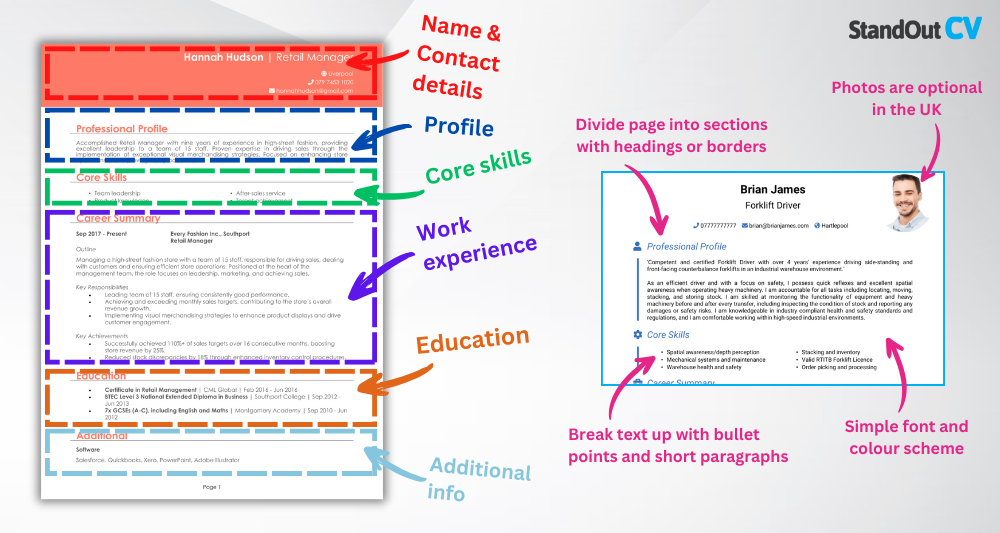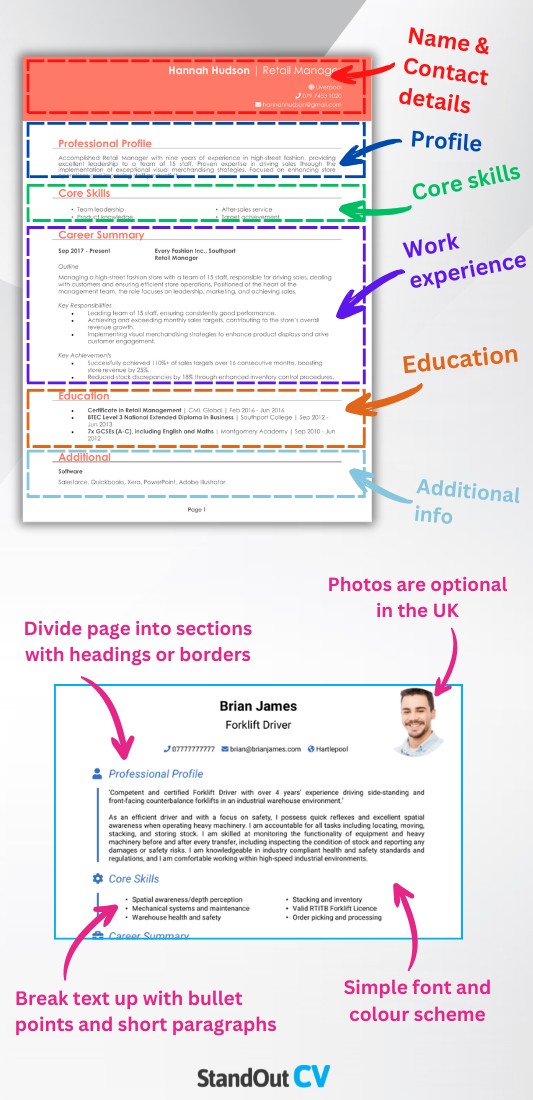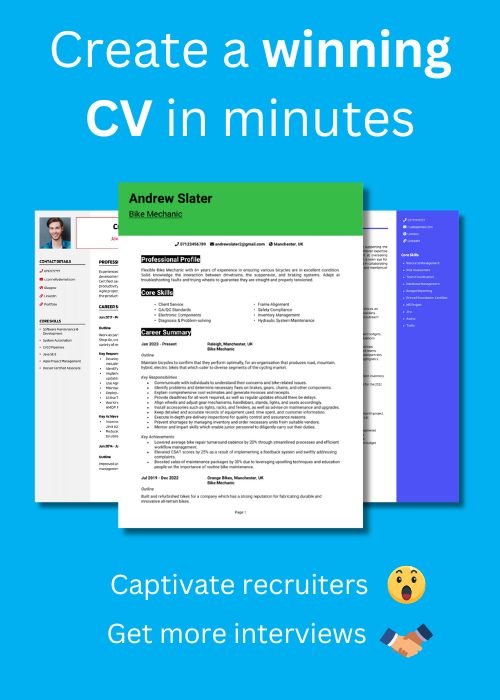Every great shot depends on what happens behind the scenes – and as a camera assistant, you’re the one keeping the wheels turning so the production stays on the right track. Your CV should work the same way, and be just as ready to support the bigger picture.
This guide and a Camera Assistant CV example will walk you through how to create a CV that captures your technical expertise and on-set experience, and the value you bring to any shoot.
Camera Assistant CV

How to write your Camera Assistant CV
Discover how to craft a winning Camera Assistant CV that lands interviews with this simple step-by-step guide.
A camera assistant’s role is all about attention to detail and anticipating what the director of photography needs before they ask. The same approach applies to writing your CV: organising your details and making sure nothing vital is out of place.
In the next sections, you’ll learn about writing your CV in a way that makes hiring managers confident you’ll be a reliable part of their crew.
The best way to structure and format your Camera Assistant CV


In production, an unorganised set slows everything down – and an unorganised CV structure has the same effect on a recruiter. A clear, consistent layout helps ensure your technical abilities and on-set experience stand out without being lost in clutter.
Here’s the layout to follow:
- Name and contact details – Place your contact info at the top so employers can get in touch easily.
- Profile – Kick things off with a concise overview of what makes you the ideal candidate for the job.
- Core skills – Briefly highlight those qualities which make you the best candidate.
- Work experience – List your previous roles in reverse chronological order, with your most recent first.
- Education – Go through the academic history which underpins your expertise.
- Additional info – This optional section can include professional memberships, awards, or hobbies and interests that showcase your suitability for the role.
Your format should aim for clarity and flow. Use bullet points to keep everything easy to skim, add clear headings for each section. Choose a professional, readable font. Keep its length to two pages maximum, but use spacing and layout to make the content easy on the eye.
What is a Camera Assistant CV profile?


Your profile should give the reader a quick but compelling sense of your background and the value you’d add to a production team. This means highlighting your experience, technical know-how, and adaptability – all framed in a way that shows why you’d be an asset on set.
Any recruiters should be assured that employing you would provide genuine value to their production, and they should be impressed enough to want to read on further.
Camera Assistant CV profile examples
Profile 1
Experienced Camera Assistant with over 12 years in film and television production, supporting cinematographers and directors on large-scale sets. Skilled in camera setup, lens changes, focus pulling, and maintaining equipment under demanding conditions. Proficient in ARRI, RED, and Sony systems, with experience in both studio and on-location shoots. Known for technical precision, adaptability, and strong teamwork on high-pressure productions.
Profile 2
Skilled Camera Assistant with seven years of experience in commercials, documentaries, and live broadcasts. Adept at rigging cameras, managing data cards, and assisting with lighting adjustments. Familiar with Steadicam, gimbals, and drone operations. Recognised for strong problem-solving skills and the ability to anticipate the needs of cinematographers and camera operators.
Profile 3
Motivated Camera Assistant with three years of experience working on independent films and music videos. Supported small crews with equipment setup, cable management, and camera maintenance. Comfortable working with DSLR and digital cinema cameras, and experienced in using editing software for basic post-production tasks. Passionate about building technical expertise and contributing to creative storytelling.
Details to put in your Camera Assistant CV profile
Make sure you include:
- Where you worked – Mention the kinds of productions you’ve supported, whether feature films, TV dramas, commercials, or documentaries.
- Your top qualifications – Note any relevant film, media, or technical training that underpins your abilities.
- Essential skills – Summarise your most relevant capabilities in a way that reflects the needs of the role you’re targeting.
- Specialist areas or equipment – Point out any particular technical areas or equipment you have extensive experience with.
- Value delivered – Explain how your contribution has kept productions running smoothly, met deadlines, or enhanced technical quality.
How to highlight your core skills


This section gives employers a quick snapshot of your capabilities, making it easy for them to match you to the demands of the role.
Focus on hard, tangible CV skills relevant to camera assisting – the kind that will be in the job description. Tailor these to the project type or production environment you’re targeting so your application feels highly relevant.
Essential skills for a Camera Assistant CV
- Camera Equipment Setup and Maintenance – Assembling, checking, and maintaining cameras, lenses, tripods, and accessories before and during shoots.
- Focus Pulling and Lens Changes – Assisting the camera operator by managing focus and swapping lenses efficiently as required.
- Clapperboard Operation and Shot Logging – Operating the slate and recording shot details to support post-production and continuity.
- Cable Management and Safety – Organising and securing cables to ensure a safe and efficient working environment on set.
- Monitor and Video Assist Setup – Connecting video feeds for directors and crew to view shots in real time during filming.
- Lighting and Exposure Assistance – Supporting the cinematographer with exposure checks, light readings, and test shots.
- Battery and Media Management – Charging batteries, swapping memory cards, and ensuring media is safely backed up and logged.
- On-Set Communication – Coordinating with departments such as lighting, grip, and sound to ensure smooth camera operation.
- Equipment Transportation and Packing – Loading, unloading, and carefully handling gear to and from set locations.
- Supporting Camera Operator – Anticipating the needs of the camera team and responding quickly to technical or creative adjustments.
How to showcase your work experience in your CV


Your work experience should show how you’ve applied your skills on set to keep the production moving and support the creative vision. Demonstrating your reliability, technical competence, and ability to work under pressure is key.
List your roles starting with the most recent and work backwards. For each role, begin with a brief outline before using bullet points to detail your responsibilities and achievements. Emphasise the impact you’ve had on production efficiency and quality.
How to format previous jobs in your CV correctly

- Outline – Describe the production, your role, and the primary purpose of your work, mentioning who you reported to and the type of shoot.
- Responsibilities – Detail your main tasks: a helpful tip is to use action words like “prepared” and “maintained.” For example: “prepared camera equipment before each shoot” or “maintained lenses and accessories to ensure image quality.”
- Achievements – Show your contribution to successful outcomes, whether that’s meeting tight shooting schedules, supporting award-winning projects, or solving on-set technical issues.
Example work history for Camera Assistants
Camera Assistant | Harrington Film Productions
Outline
Worked on television dramas and feature films for a leading UK production company. Assisted the camera department in preparing, maintaining, and operating equipment during shoots on set and on location.
Responsibilities
- Assembled and set up ARRI Alexa and RED camera systems for daily shoots
- Changed and maintained lenses, filters, and accessories as required
- Pulled focus and managed follow focus equipment during complex shots
- Organised and transported camera equipment securely between locations
- Collaborated with lighting and sound departments to ensure smooth operations
Achievements
- Contributed to three nationally broadcast TV series with zero equipment faults recorded
- Reduced setup times by 15% through improved organisation of camera kit
- Recognised by the director of photography for precision in focus pulling
Camera Assistant | Nexora Creative Studios
Outline
Provided technical and logistical support for commercial shoots and branded content at a London-based creative studio. Worked closely with cinematographers to ensure smooth production processes.
Responsibilities
- Prepared and maintained Sony FS7 and Canon C300 camera systems
- Assisted with lighting placement and minor adjustments on set
- Backed up and managed camera media cards for post-production teams
- Supported gimbal and Steadicam operations during moving shots
- Ensured batteries, memory cards, and accessories were ready for use
Achievements
- Improved efficiency of post-production handovers by creating a new file labelling system
- Supported a high-profile advertising campaign that achieved national reach
- Praised for adaptability across multiple fast-paced commercial shoots
Camera Assistant | Silverline Independent Films
Outline
Worked with small crews on independent films, documentaries, and music videos. Assisted with camera operation, equipment setup, and behind-the-scenes coordination in fast-changing environments.
Responsibilities
- Set up DSLR and Blackmagic camera rigs for short films and music videos
- Organised cables, tripods, and accessories to ensure safe and efficient shoots
- Maintained and cleaned equipment before and after filming
- Assisted with basic sound and lighting setup when required
- Provided on-set support to directors and cinematographers during shoots
Achievements
- Helped deliver five independent film projects on time and within budget
- Contributed to a short film that won a regional film festival award
- Built strong relationships with directors leading to repeat freelance contracts
Structuring your education section


Training and qualifications can help solidify your technical credibility. This might include film school degrees, media production courses, or specialist equipment certifications.
List your education in reverse chronological order, starting with the most recent. If you’ve undertaken any notable workshops, masterclasses, or manufacturer training on camera systems, mention them to show your commitment to continuous learning.
Top qualifications to showcase on a Camera Assistant CV
- BA (Hons) in Film & Television Production – Builds technical and creative foundations for on-set work.
- Diploma in Media Production – Offers practical skills for various production roles.
- Manufacturer-specific camera training (e.g., ARRI, RED) – Confirms specialist equipment proficiency.
- Health and Safety for Film and TV Certificate – Ensures safe working practices on set.
- First Aid at Work Certificate – Adds value to production teams, particularly on location shoots.





